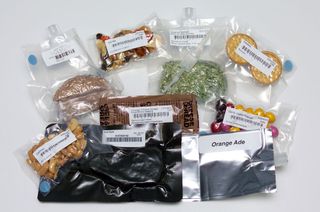Space Food Added to NASA Artifacts Menu for Schools

NASA began serving up samples of space food to U.S. schools and universities on Monday (Sept. 12), as a 'side dish' to its on-going offer of space shuttle heat shield tiles.
The "Space Food for Schools" program continues NASA's efforts to preserve the history of its recently retired space shuttle program while also inspiring the next generation of space explorers, scientists and engineers.
Approximately 350 of the three-piece meals — including an entree, a dessert and a drink — are being offered on a first come, first served basis to educational organizations that qualify. The space food, some of it freeze dried, is offered for demonstration use only, "not for consumption," NASA warns on its website. [Space Food Photos: What Astronauts Eat in Orbit]
Although specific food choices are not identified as part of the offer, NASA's pantry during the 30-year space shuttle program has been stocked with shrimp cocktail, potatoes au gratin and spaghetti with meat sauce, among a variety of other dishes. Dessert selections on the shuttle included freeze-dried strawberries and off-the-shelf sweets such as candy-coated chocolates (otherwise known as M&Ms).
To drink, astronauts could pick from coffee or tea, as well as powdered juices (Tang in its many flavors).
Under a program similar to the food offer, NASA has been distributing surplus space shuttle heat shield tiles to U.S. schools since late last year. To date, "Space Shuttle Tiles for Teachers" has distributed 4,000 of the black-and-white ceramic squares. NASA still has 3,000 available for the asking.
More than 20,000 tiles were installed on each shuttle, and each tile was designed to survive 100 trips to space and back. Varying in thickness from 1 inch (2.54 cm) to 5 inches (12.7 cm), depending on the heating they were to encounter, the tiles shielded against temperatures as high as 2,300 degrees Fahrenheit during entry into the Earth's atmosphere.
Get the Space.com Newsletter
Breaking space news, the latest updates on rocket launches, skywatching events and more!
The tiles offered to schools were never flown in space or installed on the shuttles, but were spares left over as the program came to an end.
Because both the food and tiles are government property, NASA must follow a "transfer protocol." While there is no charge for the artifacts themselves, qualifying schools do need to cover shipping and handling. "Tiles for Teachers" are offered for $23.40 while the "Space Food for Schools" carries a fee of $28.03.
NASA and the General Services Administration operate a website through which schools can apply for the food and tiles. Through the same website, NASA has been making thousands of other space artifacts available to museums, including the Smithsonian. To date, the space agency has offered about 29,000 items, out of which 3,000 have been requested by eligible organizations.
The space shuttle program came to an end Aug. 31, just over a month after its 135th and final mission landed back on Earth. NASA has awarded its remaining shuttle orbiters to museums while still retaining some of their components for possible use on future spacecraft to send astronauts to the asteroids, the moon and ultimately to Mars.
For more information and to apply to for the space food and shuttle tiles, eligible schools can visit NASA’s and the General Service Administration’s historic artifacts website.
Follow collectSPACE on Facebook and Twitter @collectSPACE and editor Robert Pearlman @robertpearlman. Copyright 2011 collectSPACE.com. All rights reserved.
Join our Space Forums to keep talking space on the latest missions, night sky and more! And if you have a news tip, correction or comment, let us know at: community@space.com.

Robert Pearlman is a space historian, journalist and the founder and editor of collectSPACE.com, an online publication and community devoted to space history with a particular focus on how and where space exploration intersects with pop culture. Pearlman is also a contributing writer for Space.com and co-author of "Space Stations: The Art, Science, and Reality of Working in Space” published by Smithsonian Books in 2018. He previously developed online content for the National Space Society and Apollo 11 moonwalker Buzz Aldrin, helped establish the space tourism company Space Adventures and currently serves on the History Committee of the American Astronautical Society, the advisory committee for The Mars Generation and leadership board of For All Moonkind. In 2009, he was inducted into the U.S. Space Camp Hall of Fame in Huntsville, Alabama. In 2021, he was honored by the American Astronautical Society with the Ordway Award for Sustained Excellence in Spaceflight History.
Most Popular



